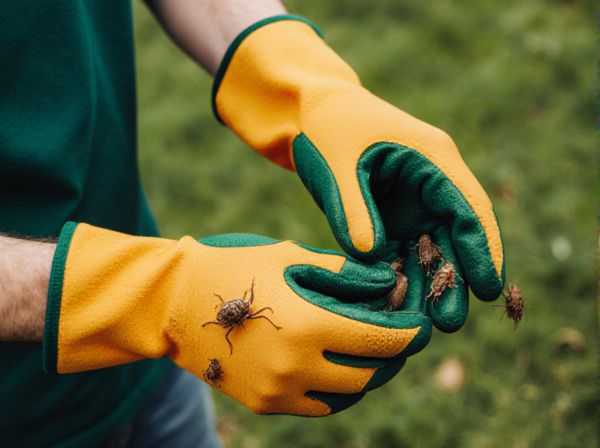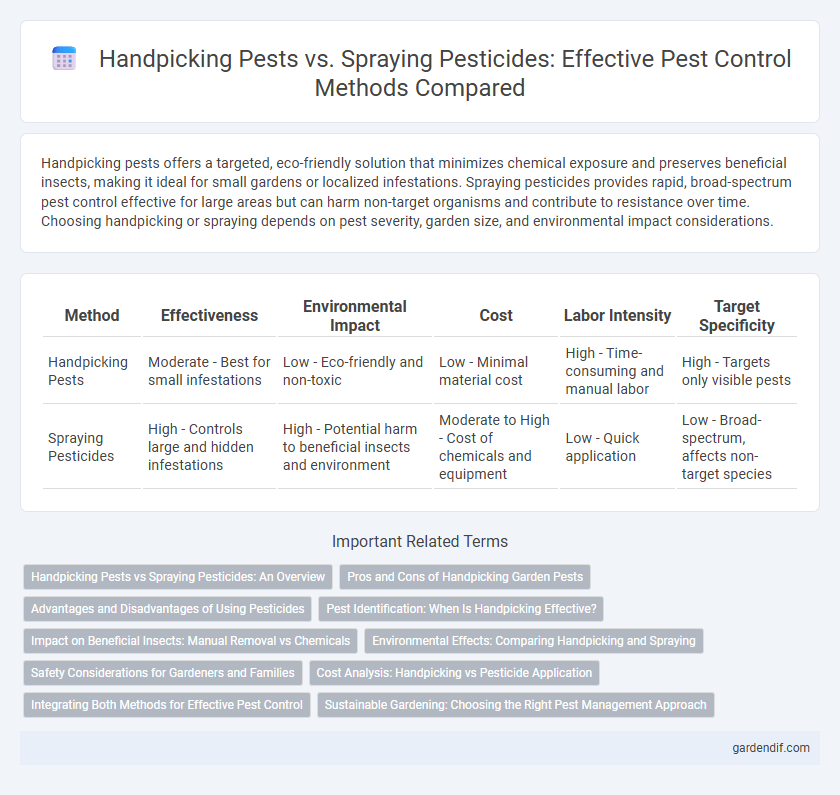
Handpicking pests vs Spraying pesticides Illustration
Handpicking pests offers a targeted, eco-friendly solution that minimizes chemical exposure and preserves beneficial insects, making it ideal for small gardens or localized infestations. Spraying pesticides provides rapid, broad-spectrum pest control effective for large areas but can harm non-target organisms and contribute to resistance over time. Choosing handpicking or spraying depends on pest severity, garden size, and environmental impact considerations.
Table of Comparison
| Method | Effectiveness | Environmental Impact | Cost | Labor Intensity | Target Specificity |
|---|---|---|---|---|---|
| Handpicking Pests | Moderate - Best for small infestations | Low - Eco-friendly and non-toxic | Low - Minimal material cost | High - Time-consuming and manual labor | High - Targets only visible pests |
| Spraying Pesticides | High - Controls large and hidden infestations | High - Potential harm to beneficial insects and environment | Moderate to High - Cost of chemicals and equipment | Low - Quick application | Low - Broad-spectrum, affects non-target species |
Handpicking Pests vs Spraying Pesticides: An Overview
Handpicking pests offers a targeted, chemical-free method ideal for small infestations, reducing environmental impact and protecting beneficial insects. Spraying pesticides provides rapid control over large pest populations but carries risks of chemical resistance, non-target species harm, and environmental contamination. Choosing between these methods depends on infestation severity, crop sensitivity, and sustainability goals in pest management.
Pros and Cons of Handpicking Garden Pests
Handpicking garden pests offers precise control, minimizing chemical exposure and safeguarding beneficial insects, making it an eco-friendly pest management method ideal for small gardens. This method is labor-intensive and impractical for large infestations or extensive garden areas, requiring regular monitoring and physical effort. Despite its limitations, handpicking reduces pesticide resistance and environmental contamination, promoting sustainable gardening practices.
Advantages and Disadvantages of Using Pesticides
Using pesticides offers the advantage of rapid and effective pest control for large infestations, saving time and labor compared to handpicking. However, pesticides pose environmental risks such as soil and water contamination, harm to non-target species, and potential development of pest resistance. Proper application and integrated pest management strategies are essential to minimize health hazards and ecological damage while maximizing pest control efficiency.
Pest Identification: When Is Handpicking Effective?
Handpicking pests is most effective when pest populations are low and easily identifiable, such as caterpillars, beetles, or aphids on individual plants. Accurate pest identification is crucial to determine which species can be manually removed without harming beneficial insects or plants. Spraying pesticides becomes necessary when infestations are widespread or involve pests that are difficult to reach or identify precisely by hand.
Impact on Beneficial Insects: Manual Removal vs Chemicals
Handpicking pests targets harmful insects directly, preserving beneficial insect populations essential for pollination and natural pest control. Spraying pesticides often harms non-target beneficial insects such as bees and ladybugs, disrupting ecosystem balance and reducing biodiversity. Maintaining beneficial insect health through manual removal promotes sustainable pest management and long-term agricultural productivity.
Environmental Effects: Comparing Handpicking and Spraying
Handpicking pests minimizes chemical runoff and preserves beneficial insects, reducing environmental pollution compared to spraying pesticides. Spraying pesticides often leads to soil and water contamination, harming non-target species and disrupting ecosystems. Choosing handpicking supports sustainable pest control by maintaining biodiversity and preventing chemical resistance.
Safety Considerations for Gardeners and Families
Handpicking pests reduces exposure to harmful chemicals, making it the safest option for gardeners and families, especially around children and pets. Spraying pesticides introduces toxic substances that can contaminate soil, water, and air, increasing health risks such as skin irritation, respiratory issues, and long-term effects. Safety protocols like wearing protective gear and following label instructions are critical when using pesticides to minimize adverse impacts on human health.
Cost Analysis: Handpicking vs Pesticide Application
Handpicking pests requires minimal upfront investment, primarily labor costs, making it cost-effective for small-scale gardens but labor-intensive and time-consuming for larger areas. Pesticide application involves higher initial expenses for chemicals and equipment but can cover extensive areas quickly, reducing manual labor and potentially lowering overall operational costs. Evaluating cost-effectiveness depends on pest severity, garden size, and long-term environmental impact, with handpicking offering organic benefits and pesticides risking resistance development.
Integrating Both Methods for Effective Pest Control
Integrating handpicking pests with spraying pesticides enhances pest control by combining precise removal with broad-spectrum coverage, reducing pesticide resistance and minimizing environmental impact. Targeted handpicking disrupts pest reproduction cycles, while strategic pesticide application controls outbreaks that surpass manageable handpicking levels. This integrated approach optimizes crop health by balancing natural pest management with chemical intervention.
Sustainable Gardening: Choosing the Right Pest Management Approach
Handpicking pests offers a sustainable gardening approach by reducing chemical use and preserving beneficial insects, making it ideal for small infestations and organic gardens. Spraying pesticides can provide quick and broad-spectrum pest control but risks harming pollinators, soil health, and causing pesticide resistance. Selecting the right pest management strategy depends on pest severity, garden size, and environmental impact, with integrated pest management (IPM) practices promoting balance between effectiveness and sustainability.
Handpicking pests vs Spraying pesticides Infographic

 gardendif.com
gardendif.com